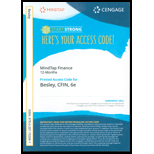
Bond L has a face value of $1,000 with annual interest rate of $100, matures in 15 years with rate of interest of a) 5 percent and b) 7 percent. Bond S also has a face value of $1,000 and an annual interest rate of $100, matures in 15 years with rate of interest of a) 5 percent and b) 7 percent.
Bonds are issued to raise funds for the company. The important characteristic of a bond is that it has a maturity value which is the value the bondholders will get at the end of the maturity period. Also, some bonds carry coupon rate which means the bondholders will get a regular interest cash flow on that bond.
The yield to maturity (YTM) of the bond is the required
Where,
INT = coupon payments made
N = number of periods
M = Maturity or Face value
rd = rate of return
Vd = Value of the bond
Want to see the full answer?
Check out a sample textbook solution
Chapter 6 Solutions
CFIN -STUDENT EDITION-ACCESS >CUSTOM<
- Finance question. None please listen if you deslike my answer i will give your. Also if you will give more deslike bartleby site will be shut down.arrow_forwardCorrect solnarrow_forwardplease listen if you deslike my answer i will give in your answer. Bartleby also changed the rule for this change we all are responsible so please don't do this. Also if we will give more deslike bartleby site will be shut down.arrow_forward
- Muskoka Tourism has announced a rights offer to raise $30 million for a new magazine, titled ‘Discover Muskoka’. The magazine will review potential articles after the author pays a nonrefundable reviewing fee of $5,000 per page. The stock currently sells for $52 per share and there are 3.9 million shares outstanding. Required What is the maximum possible subscription price? What is the minimum? If the subscription price is set at $46 per share, how many shares must be sold? How many rights will it take to buy one share? What is the ex-rights price? What is the value of a right?arrow_forwardNorthern Escapes Inc. has 225,000 shares of stock outstanding. Each share is worth $73, so the company’s market value of equity is $16,425,000. Suppose the firm issues 30,000 new shares at the following prices: $73, $69, and $60. What will the effect be of each of these alternative offering prices on the existing price per share?arrow_forwardNeed answer correctly.arrow_forward
- Principles of Accounting Volume 1AccountingISBN:9781947172685Author:OpenStaxPublisher:OpenStax College

 College Accounting, Chapters 1-27AccountingISBN:9781337794756Author:HEINTZ, James A.Publisher:Cengage Learning,
College Accounting, Chapters 1-27AccountingISBN:9781337794756Author:HEINTZ, James A.Publisher:Cengage Learning,


